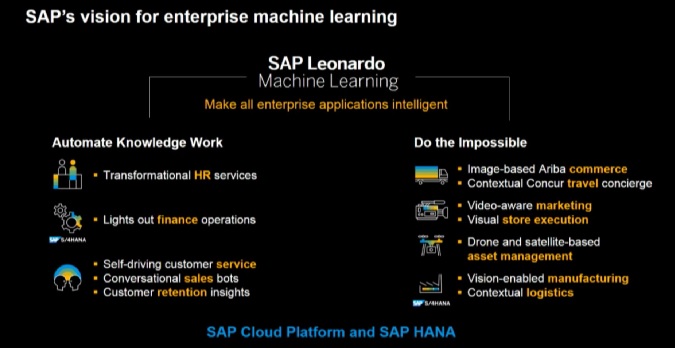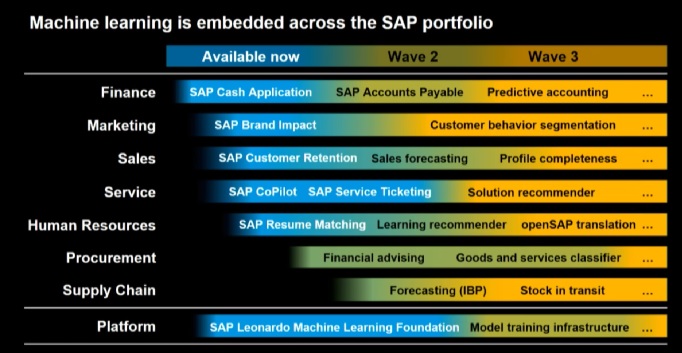SAP Leonardo will harness machine learning to help customers drive automation and innovation. Here’s a closer look at what’s available and what’s coming.
When SAP introduced Leonardo on May 18 at its Sapphire Now event in Orlando, executives insisted that “no single technology can deliver digital innovation on its own.” Yet it’s clear that machine learning is a cornerstone technology that SAP is counting on to help customers come up with innovative new products, new business processes and even new business models.
Leonardo was described as a framework that brings machine learning, big data, analytics, IoT, S4/Hana and the SAP Cloud Platform together with process and industry knowledge and design-thinking methodologies. That’s a lot to consider. As the data-to-decisions analyst at Constellation Research, I focused on learning more about the machine learning aspects of Leonardo. Here’s what I found out.
SAP's goal with machine learning is to turn all applications into intelligent, highly automated
applications with five to seven years.
SAP Standardizes on Google TensorFlow
SAP already had machine learning technologies on hand, including the Automated Predictive Library (APL) gained through its KXEN acquisition and the Predictive Analytics Library (PAL) built into SAP Hana. But Juergen Mueller, chief innovation officer, announced at Sapphire that SAP has settled on Google’s TensorFlow library as its standard for development.
Mueller cited Google’s leadership in machine learning during a joint appearance with Google executive Francisco Uribe, and he said that TensorFlow deep learning capabilities, in particular, would power Leonardo speech recognition, image recognition, text translation, and natural language services. What’s more, Mueller said SAP is working directly with Google’s machine learning team, not just using the open source TensorFlow libraries that are available to anybody.
In a deeper, one-on-one discussion, Dr. Markus Noga, SAP’s vice president of machine learning, told me that APL and PAL are fine for tabular and time-series data and traditional analytics scenarios. TensorFlow, he said, is being applied to challenges including natural language processing, image and video recognition, and unstructured data such as invoice images, PDF documents, email and broadcast video. He also told me that the work with Google began many months before the partnership was formally announced at the Google Cloud Next 17 event in March.
SAP Plans Waves of ML-Powered Applications
Just how will SAP make ML capabilities accessible? Well, in order to jump start innovation, Noga said SAP took an application-led approach, applying ML to common business processes supported in SAP software. The goal was to rethink business processes by automating repetitive, tedious tasks using machine learning while leaving the exceptions and harder corner cases to humans. At Sapphire, SAP unveiled the first of at least three planned waves of machine-learning powered applications:
- SAP Cash Application: Automates the tedious payment-to-invoice matching process, relying on ML to learn from historical payment patterns and automatically clear payments.
- SAP Fraud Management: Employs predictive algorithms to reduce false positives that derail legitimate transactions and false negatives that let fraudulent transactions go through.
- SAP Resume Matching: Uses ML to automate resume screening and match best candidates to jobs descriptions without bias, thereby speeding the recruiting process.
- SAP Brand Impact: Applies deep-learning-based recognition to spot brand and product logos within images and videos, statistically measuring impressions and the return on investment on sponsorships and advertising.
- SAP Service Ticketing: Taps ML to automatically classify, route and respond to inbound social media posts, e-mails, and other customer inquiries.
- SAP Customer Retention: Mines history and monitors digital interactions to capture churn indicators and predict customer behaviors such as cancellations.
As shown in the slide below, which was shared at Sapphire, SAP will soon launch a second wave of applications, including procurement and supply chain apps. A third wave (release date unspecified) will bring the total to nearly 20 apps. Noga described the apps as Lego-like components designed to “snap into place” alongside existing SAP applications. The SAP Cash App, for example, integrates with S4/Hana, while SAP Service Ticketing integrates with the Hybris Service Cloud.
These aren’t apps that are ready to run “out of the box.” They have to be configured for each individual customer. SAP has developed pretrained models based on aggregated data, but Noga said each deployment is fine tuned per customer based on their specific data. “We’ll have large, shared models and small, customer-specific models,” he told me.
SAP has released a first wave of ML-enabled "apps," listed in blue, and it has two more waves of
these "snap-in" process components in the works.
Leonardo ML Services Will Support Custom Apps
SAP says customers will also be able to design and develop custom apps using the SAP Leonardo Machine Learning services. At this writing, ten Leonardo Machine Learning APIs are available on the SAP API Business Hub. The idea is to combine your data – the higher the scale, the better – with these services to “add intelligence to your application.”
As described by SAP executives, you won’t need data scientists to build ML-powered custom apps. Rather, developers will invoke services through APIs and add small snippets of code. In a solution briefing at SAP.com/ML, the company cited multiple use case scenarios.
- Manufacturers can use image classification and image feature-extraction services to support quality inspections while service organizations can use these services to inspect assets for wear or defects and automatically order required parts.
- Brands can use natural language services to monitor social media and detect what customers are saying about your products or brand and identify trends that might shape future products.
- Retailers can use image recognition to enable customers to upload images to simplify product searches
- Logistics and sales can use ML services to anticipate changes in demand or inventory requirements.
My Take on SAP Leonardo Machine Learning
I appreciate that SAP has couched this as a machine learning initiative rather than contributing to today’s rampant “artificial intelligence” hyperbole. I also appreciate that SAP has partnered with Google and is using TensorFlow, a leading, open-source library, rather than falling prey to not-invented-here thinking and coming up with a proprietary approach.
If the experience of BASF is any indication, customers can look forward to substantial benefits from the ML-powered apps. BASF was a beta customer and development partner for the SAP Cash Application. Speaking at Sapphire, Wiebe van der Horst, CIO at the chemical company, said SAP R3 is able to automatically match only about 40% of payments to invoices out of the box. By adding hard-coded rules, BASF has achieved automation rates as high as 70%, but that has required time-consuming maintenance of rules. Using the SAP Cash Application, Van der Horst says BASF has automated as much as 94% of payment-to-invoice matching.
What’s not clear, and what will have to be validated by customer experience, is just how much effort will be required to implement and customized the ML-powered app components or to build custom apps with ML services from the SAP Cloud Platform. “It was a good engagement with SAP, but we were very early,” said Van der Horst. “With the packaging into Leonardo, it should be much easier to deploy.”
What also has yet to be seen is how quickly SAP customers will embrace Leonardo and just how differentiating these capabilities can be for customers and for SAP. Noga was refreshingly honest when he admitted that SAP’s data will ultimately stand as the differentiator. Any company can make use of TensorFlow because it is open source, he said. Any company can use GPUs to power deep learning, as SAP is exploring on its cloud platform. And any company can go to Open.ai and download whitepapers to learn how to best use machine learning, he said.
“But not every company has an Ariba network transacting more than $900 billion in commerce annually, or a Concur serving 47 million business travelers per year, or a Fieldglass placing more than 3 million freelancers in positions every year,” said Noga.
Throw in S4/Hana, Business ByDesign, SuccessFactors and SAP’s other, data-generating assets, and there’s good reason to expect that SAP will be able to come up with powerful shared models that will fuel customer-specific innovation.
Related Reading:
Oracle Launches Adaptive Intelligent Apps for CX
Inside Salesforce Einstein Artificial Intelligence
Google Cloud Invests In Data Services and ML/AI, Scales Business




